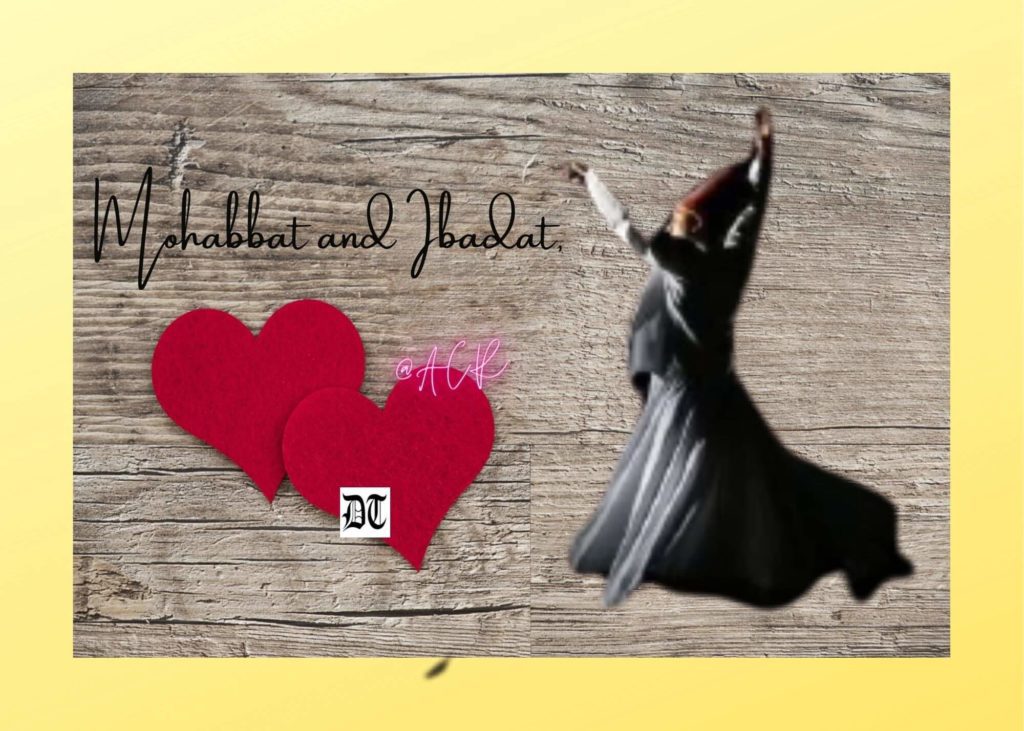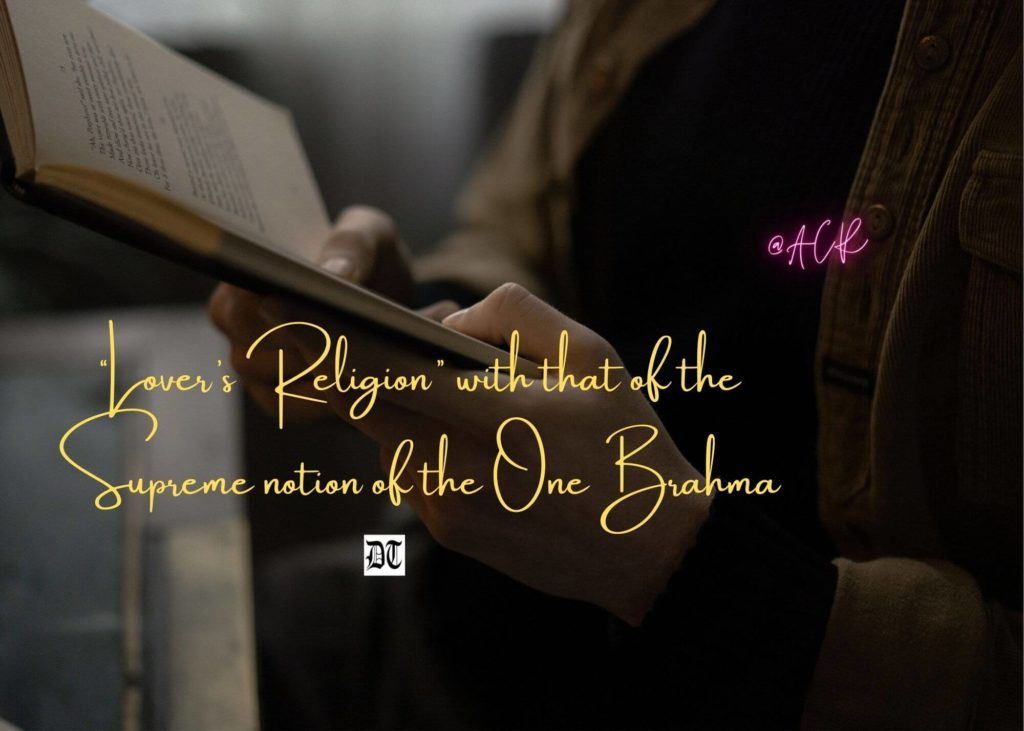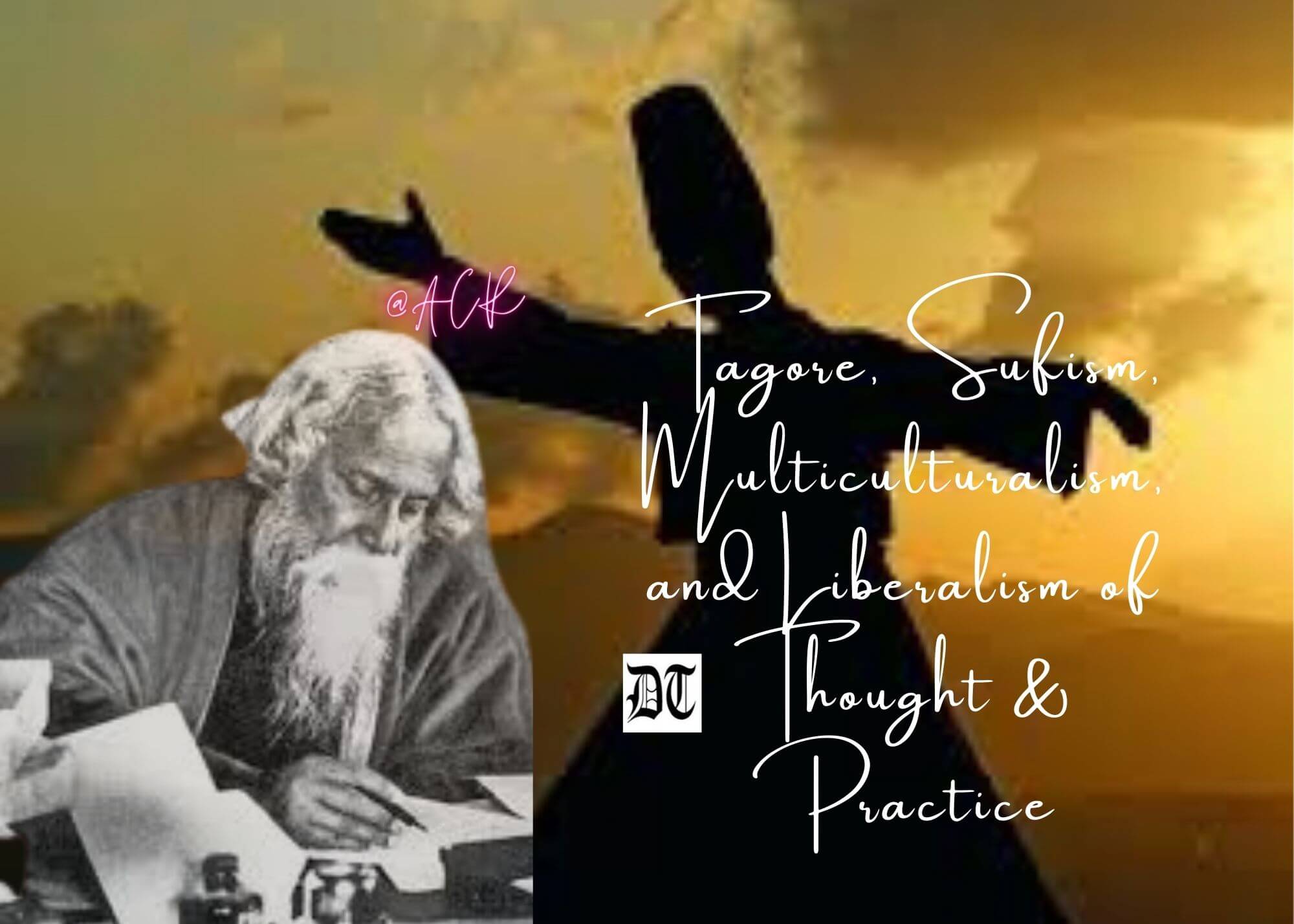Reading Time: 8 minutes
In the second and concluding part, Prof Laksmisree deepens her exploration of Tagore and Sufism in the light of multiculturalism and liberalism of thought and practice. She elucidates that by the end of the 14th century … the appeal which the Hindi language made to the Sufis brought Hindus and Muslims closer together. An exclusive for Different Truths.
In his book titled, The IndianMuslims, and his chapter on ‘Sufis and Sufism’, Dr. M. Mujeeb talks about the integrative force of this philosophy which becomes significant in the understanding of Tagore’s multiculturalism and liberalism of thought and practice. Mujeeb writes: “Love is the means of union with man and God and is, therefore, given the highest importance. This metaphysical approach may be traced to other influences as well which have obviously been taken from Hindu philosophy. They point to an infiltration of ideas that could ultimately have led to an assimilation (of the Sufi and Hindu philosophies). By the end of the 14th century the devotional character of Hindi songs and the philosophic concepts of Hinduism as well as the appeal which the Hindi language made to the Sufis brought Hindus and Muslims closer together than any other influences – the Sufis made an intuitive choice of the common ground of spirituality between Hindus and Muslims and opened the way for a mutual appreciation of values which could revolutionise the whole cultural attitude of the Muslims.”
…the travelling gypsies of Central and Western Asia would have joined the migratory singing and dancing tribes of India and actively contributed to this Sufi element of our Indian ethos.
It may also be asserted that the travelling gypsies of Central and Western Asia would have joined the migratory singing and dancing tribes of India and actively contributed to this Sufi element of our Indian ethos. In this context one cannot belittle the rich influence on Tagore’s creative writings of the rural bards or Bauls and their Bengali folk songs, with their endless search for the ‘Moner Manush’ or the Eternal Lover dwelling in the human mind, as well as the all-encompassing melodies of the Hindustani Classical Music System or Khayal (implying the freedom of the imaginative spirit) largely attributed to the Sufi poet and musician Amir Khusro of the 13th Century. In confirming the totally secular and eclectic character of Indian Classical Music, which so deeply permeates Tagore’s compositions, it may safely be asserted that both Tagore and Sufism have immense contemporary relevance for the eradication of ethnic/parochial conflicts and of the barriers between man and man, for crossing bridges in attaining the highest goals of peace and tranquility.
In the comparative study of Sufism, ‘Brahmo-ism’, the Vedanta, Western Romanticism, Transcendentalism, Folklore, Hindusthani Sangeet, the ‘Bhakti’ cult and a certain higher form of Pantheism, it seems certain that these variants have consciously or unconsciously permeated the integrative fabric of Tagore’s compositions, with a definite erasure of frontiers and dogmatic categorisations. In terms of the Sufist philosophy of the unifying force of love, Tagore, like Kabir, Amir Khusrau and Rumi revels in the effacement of the divides between the transcendental and the temporal, the deeply spiritual and the intensely sensual, between God, man and nature and the impediments of caste and creed. The resonance and depth of Mysticism enriches most of Tagore’s poetry regardless of its ramifications or classifications under various titles of his segments and books.
The Sufi blend of Mohabbat and Ibadat, or of love and worship seems to be a constant line of thought, imagery, and symbolism in most of Tagore’s poetic writings.
The Sufi blend of Mohabbat and Ibadat, or of love and worship seems to be a constant line of thought, imagery, and symbolism in most of Tagore’s poetic writings. In this context one would wish to draw some empathetic lines of references and thematic equivalence between Tagore, Kabir, Khusrau and Rumi (there are a host of others who cannot be included here for space-constraints). The resplendence of Divinity, nature and human bonding comes through in what Mohit Chakraborty enunciates and defines in his book, Rabindranath Tagore: A Quest, as “The unending crystallisation and beyonding of consciousness for the unison of the Being with the ever-abiding all beautiful”. In Tagore’s lines one sees a slow and steady progression from the detailed realities of life and nature to the fulfillment of a higher unity through mystical abstractions and allegories, in much the same way as in Sufi poetry. He writes:
“My heart, the bird of the wilderness, has found its sky in your eyes. They are the cradle of the morning, they are the kingdom of the stars. I am only waiting for love to give myself up at last into his hands He it is the innermost one, who awakens my being with his deep hidden touches. The great pageant of thee and me has overspread the sky. With the tune of thee and me all the air is vibrant and all ages pass…”.
The related motifs of Viraha or separation and of Milan or union with the Beloved and/ or the Supreme Being is a perennial theme of Tagore’s poetry as well as that of the Sufis and of the
Vaishnavite poets, all of whom predominantly sing ecstatically of a timeless form of happiness and harmony, which could transform our beleaguered, bleak world.

The central theme of love is also the cornerstone of the Sufi poetry and music of Amir Khusrau, who is known to be the pioneer of Indian Classical Music…
The central theme of love is also the cornerstone of the Sufi poetry and music of Amir Khusrau, who is known to be the pioneer of Indian Classical Music and other related North Indian musical genres which have also greatly impacted Tagore’s music, though in an informal and non-structured manner. Khusrau’s poetry, an interesting amalgam of Persian, Urdu, Braj Bhasha, Awadhi and Hindi, becomes the greatest testament of what Tagore believed and preached as Indian Secularism and Multi-culturalism. One may easily perceive some of Tagore’s deeply felt convictions reflected in the following excerpts translated from Amir Khusrau’s, Collected Works,
I am a pagan (kafir) and a worshipper of love: the creed (of Muslims) I do not need Every vein of mine has become taut like a wire, The Brahmin’s girdle I do not need – The attraction of love won’t leave you unmoved; My soul has come on my lips Come so that I may remain alive –
The next few lines are from Khusrau’s oft-sung famous composition beginning:
‘Zehal –e-miskin makun taghaful, duraye naina banaye batiyan’, which translates as “Do not overlook my misery by blandishing your eyes – Oh sweetheart, why do you not take me to your bosom – My dear, how will I pass the dark dungeon night Without your face before me”.
Rumi’s most well-known work titled, Masnavi-Ye-Manavi, embodies the crux and crescendo of Sufi poetry, the metaphors, images, and ideas of which are remarkably evident in Tagore as well.
Jalaluddin Rumi, the earlier mentioned 13th century Persian Sufi poet who lived most part of his life in Anatolia, a part of the Byzantine Empire was born in Balkh (present day Afghanistan) and may have also travelled to several parts of Western and Southern Asia and the Indian subcontinent, in having preached and performed his special kind of Divine music and dance called the Sema, better known as the Mehvlevi Order of “The Whirling Dervishes”. Rumi’s most well-known work titled, Masnavi-Ye-Manavi, embodies the crux and crescendo of Sufi poetry, the metaphors, images, and ideas of which are remarkably evident in Tagore as well. In Masnavi, Rumi describes in detail the universal message of love through the transcendence of all forms of temporal limitations and hostilities for the achievement of the same global peace and universal brotherhood that Tagore had practiced and written about with a missionary zeal:
“Love’s nationality is separate from all other religions, For the lover’s religion and nationality is the Beloved. I am neither Christian nor Jew, neither Magian nor Muslim, I am not from east or west, not from land or sea Not of the earth, not of water, not of air, not of fire Not from existence, not from being. My place is placeless, my trace is traceless, I have chased out duality, lived the two worlds as one. One I seek, One I know, One I see, One I call. Beyond the One, I know no other. I am drunk from the cup of love, I have no concern but rapture”.
In such lines of the Sufi poet, one cannot but be struck by the remarkable affinity of the archetypal elements of this “Lover’s Religion” with that of the Supreme notion of the One Brahma, who also pervades so ubiquitously Tagore’s poetic universe and his goal of a human world celebrating diversity in a symphony of togetherness (which Tagore accentuates in his Religion of Man). More significantly, one also finds in the above lines a resonance of the same remedial aspects of a borderless humanism which Tagore believed would defeat all negative forces of our world. In defining this elemental Sufi spirit of unity in Tagore’s compositions, one cannot but refer to that famous crescendo so graphically constructed by Tagore in his poem titled, Bharat Tirtha, in which he eulogizes India as an exemplary pilgrimage and meeting point of all shades, creeds, colours and races of humanity:

“Esho hey Arya, esho Anarya, Hindu, Mussalman” (Bangla, See Eng. Translation by self),
“Come O Aryans, come Non-Aryans, come Hindus and Muslims. / Come, come O Englishmen, come Christians, come Brahmins, purify your hearts and hold the hands of the down-trodden and out-castes./ Remove all your ills, barriers and mutual disrespect. /Come quickly for the coronation of the Motherland / And fill the blessed urn with that sacred water which is consecrated by the touch of One and All/ Along this great Indian Seashore of Humanity “.
… the poems of Tagore, as of the Sufi-seers be considered and celebrated as the most potent instruments of international understanding…
One needs to revive urgently these values of benevolent universalism to save our environment from impending disaster. It is a matter of great urgency that the poems of Tagore, as of the Sufi-seers be considered and celebrated as the most potent instruments of international understanding and inter-cultural peace and a panacea for our tragically shredded, conflict-ridden, world of today, almost on the brink of devastation.
(Concluded)
Works Cited:
1. Edward Thompson, Rabindranath Tagore: Poet & Dramatist, OUP, 1989.
2. Stephen Mitchell, The Enlightened Heart, Harper Collins, 1993.
3. Mohit Chakravarti, Rabindranath Tagore: A Quest, Gyan Publishing House, 1995.
4. Rabindranath Tagore & The British Press, The Tagore Centre, London, 1990.
5. Wendy Barker, Rabindranath Tagore: Final Poems, Translated by Sharadindranath Tagore, George Braziller, 2001.
6. Rabindranath Tagore, A Centenary Volume, Sahitya Akademi Publishers, 1961
7. Songs of Kabir:A 15th Century Sufi Literary Classic, New Edition, Introduction by Andrew Harvey, Weiser Books, 1988
8. Songs of Kabir, Translated by Rabindranath Tagore, 1st Publication by Macmillan
Company, New York, 1915.
9. Peter Hees, Indian Religions, A Historical Reader of Spiritual Expression & Experience, NYU Press, New York, 2002.
10. Charlotte Vaudeville, A Weaver Named Kabir: Selected Verses with a Detailed Biographical Introduction, New Edition, OUP, 1998.
11. Woodhead, Linda & Fletcher, Paul, Religion in the Modern World:Traditions & Transformations, Routledge, UK, 2001.
12. “Amir Khusro”, Story of Hindustani Classical Music, ITC Sangeet Research Academy, Calcutta, 2000.
13. M. Mujeeb, The Indian Muslims, Manoharlal Publishers, Delhi, 1998.
14. Shushud Hassan, Masters of Wisdom of Central Asia, “Sufism”, Coombe Springs Press, UK, 2003.
15. R.K. Gupta, Sufism Beyond Religion, BRPC Publishers, Delhi, 1998.
16. Idries Shah, The Sufis, (ISBN 0-385-07966-4), 1971.
17. Idries Shah, The Way of the Sufi, (ISBN 0-14-019252), 1991.
18. A.J. Arberry, Mystical Poems of Rumi, Vols. I & II, Chicago University Press, 1991.
19. Carl Ernst, The Shambhala Guide to Sufism, Boulder, Shambhala, 1997.
20. Frederick Colby, The Subtleties of the Ascension, Fons Vitae, Louisville, 2006.
21. E.H. Whinfield (Translator), Masnavi–i–Manavi: The Spiritual Couplets of Jalaluddin Muhammad Rumi, 1887, New Edition, 1989.
22. C.E. Wilson, The Masnavi of Jalaluddin Rumi, Translated from Persian for the first time with a Commentary, London, 1910.
23. Reynold. A. Nicholson, The Masnavi of Jalaluddin Rumi, 8 Vols, Luzac & Co, London, 1925-1940.
24. Coleman Barks, The Illuminated Rumi, Broadway Books, New York, 1997.
25. Majid. M. Naini, The Mysteries of the Universe and Rumi’s Discoveries on the Majestic Path of Love, (ISBN 0-9714600-0-0), Universal Vision & Research, 2002.
26. Leslie Wines, Rumi:A Spiritual Biography, Crossroads, New York, 2001.
27. Sefik Can, Fundamentals of Rumi’s Thought:A Mevlevi Sufi Perspective, Sommerset, New Jersey
Visuals by Different Truths















